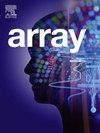An Ensemble Learning Framework with Explainable AI for interpretable leaf disease detection
IF 2.3
Q2 COMPUTER SCIENCE, THEORY & METHODS
引用次数: 0
Abstract
The early and accurate detection of plant diseases is critical for sustainable agriculture, ensuring crop health, reducing losses, and supporting food security. To address this challenge, we present an Ensemble Learning Framework with Explainable AI (XAI) tailored to disease detection, using cucumber leaf diagnosis as a key use case. In this study, we experimented with a dataset comprising 6,400 images capturing six prevalent cucumber leaf diseases – Gummy Stem Blight, Downy Mildew, Anthracnose, Bacterial Wilt, Belly Rot, and Pythium Fruit Rot – alongside two healthy categories. Prior to training, the images underwent preprocessing steps such as resizing, rescaling, and data augmentation (through random rotations, flips, zooms, and contrast adjustments) to enhance model generalization. The proposed framework unites multiple architectures – CNN, DenseNet121, EfficientNetB0, InceptionV3, MobileNetV2, ResNet50, and Xception – into an ensemble that attained overall accuracy of 99%, alongside high recall and F1-scores. Individual models demonstrated accuracy ranging from 88.71% to 99%, underscoring the robustness of the ensemble. Integrating XAI methods further ensures interpretable outputs, granting valuable insights into the decision-making process and heightening transparency for researchers and agronomists. The findings confirm that transfer learning, model ensembling, and interpretability methods significantly enhance classification performance, especially in cases of limited data, offering a scalable solution for improved disease management in agriculture. Additionally, the framework is scalable for real-world deployment by enabling real-time disease monitoring on edge devices (e.g., Raspberry Pi, IoT systems), seamless integration with smart farming platforms, and continuous learning for adaptive crop management.
基于可解释人工智能的叶片病害检测集成学习框架
早期和准确发现植物病害对于可持续农业、确保作物健康、减少损失和支持粮食安全至关重要。为了应对这一挑战,我们提出了一个针对疾病检测的可解释人工智能(XAI)集成学习框架,以黄瓜叶片诊断为关键用例。在这项研究中,我们对一个包含6400张图像的数据集进行了实验,这些图像捕获了六种常见的黄瓜叶片疾病-胶茎枯萎病,霜霉病,炭疽病,细菌性枯萎病,腹腐病和皮腐病-以及两种健康类别。在训练之前,图像经过预处理步骤,如调整大小、重新缩放和数据增强(通过随机旋转、翻转、缩放和对比度调整),以增强模型泛化。提出的框架将多个架构(CNN、DenseNet121、EfficientNetB0、InceptionV3、MobileNetV2、ResNet50和Xception)结合在一起,达到99%的总体准确率,同时具有高召回率和f1分数。单个模型的准确率在88.71%到99%之间,强调了整体的鲁棒性。集成XAI方法进一步确保了可解释的输出,为决策过程提供了有价值的见解,并提高了研究人员和农学家的透明度。研究结果证实,迁移学习、模型集成和可解释性方法显著提高了分类性能,特别是在数据有限的情况下,为改善农业疾病管理提供了可扩展的解决方案。此外,通过在边缘设备(例如树莓派、物联网系统)上实现实时疾病监测,与智能农业平台无缝集成,以及持续学习自适应作物管理,该框架可扩展到实际部署。
本文章由计算机程序翻译,如有差异,请以英文原文为准。
求助全文
约1分钟内获得全文
求助全文

 求助内容:
求助内容: 应助结果提醒方式:
应助结果提醒方式:


